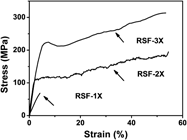Crossref Citations
This article has been cited by the following publications. This list is generated based on data provided by
Crossref.
Wei, Wei
Zhang, Yaopeng
Zhao, Yingmei
Luo, Jie
Shao, Huili
and
Hu, Xuechao
2011.
Bio-inspired capillary dry spinning of regenerated silk fibroin aqueous solution.
Materials Science and Engineering: C,
Vol. 31,
Issue. 7,
p.
1602.
Luo, Jie
Zhang, Yaopeng
Huang, Yan
Shao, Huili
and
Hu, Xuechao
2012.
A bio-inspired microfluidic concentrator for regenerated silk fibroin solution.
Sensors and Actuators B: Chemical,
Vol. 162,
Issue. 1,
p.
435.
Sun, Mengjie
Zhang, Yaopeng
Zhao, Yingmei
Shao, Huili
and
Hu, Xuechao
2012.
The structure–property relationships of artificial silk fabricated by dry-spinning process.
Journal of Materials Chemistry,
Vol. 22,
Issue. 35,
p.
18372.
Fan, Suna
Zhang, Yaopeng
Shao, Huili
and
Hu, Xuechao
2013.
Electrospun regenerated silk fibroin mats with enhanced mechanical properties.
International Journal of Biological Macromolecules,
Vol. 56,
Issue. ,
p.
83.
Mhuka, Vimbai
Dube, Simiso
Nindi, Mathew Muzi
and
Torto, Nelson
2013.
Fabrication and structural characterization of electrospun nanofibres from Gonometa Postica and Gonometa Rufobrunnae regenerated silk fibroin.
Macromolecular Research,
Vol. 21,
Issue. 9,
p.
995.
Jin, Yuan
Zhang, Yaopeng
Hang, Yichun
Shao, Huili
and
Hu, Xuechao
2013.
A simple process for dry spinning of regenerated silk fibroin aqueous solution.
Journal of Materials Research,
Vol. 28,
Issue. 20,
p.
2897.
Zhou, Huan
Shao, Zheng-zhong
and
Chen, Xin
2014.
Wet-spinning of regenerated silk fiber from aqueous silk fibroin solutions: Influence of calcium ion addition in spinning dope on the performance of regenerated silk fiber.
Chinese Journal of Polymer Science,
Vol. 32,
Issue. 1,
p.
29.
Luo, Jie
Zhang, Lele
Peng, Qingfa
Sun, Mengjie
Zhang, Yaopeng
Shao, Huili
and
Hu, Xuechao
2014.
Tough silk fibers prepared in air using a biomimetic microfluidic chip.
International Journal of Biological Macromolecules,
Vol. 66,
Issue. ,
p.
319.
Kim, Hyun Ju
and
Um, In Chul
2014.
Effect of degumming ratio on wet spinning and post drawing performance of regenerated silk.
International Journal of Biological Macromolecules,
Vol. 67,
Issue. ,
p.
387.
Jin, Y.
Hang, Y. C.
Zhang, Y. P.
Shao, H. L.
and
Hu, X. C.
2014.
Role of Ca2+on structures and properties of regenerated silk fibroin aqueous solutions and fibres.
Materials Research Innovations,
Vol. 18,
Issue. sup2,
p.
S2-113.
Huot, Alexandrine
Lefèvre, Thierry
Rioux-Dubé, Jean-François
Paquet-Mercier, François
Nault, Anne-Philipe
Auger, Michèle
and
Pézolet, Michel
2015.
Effect of Mechanical Deformation on the Structure of Regenerated Bombyx mori Silk Fibroin Films as Revealed Using Raman and Infrared Spectroscopy.
Applied Spectroscopy,
Vol. 69,
Issue. 6,
p.
689.
Lefèvre, T.
and
Auger, M.
2016.
Spider silk inspired materials and sustainability: perspective.
Materials Technology,
p.
1.
Lefèvre, Thierry
and
Auger, Michèle
2016.
Spider silk as a blueprint for greener materials: a review.
International Materials Reviews,
Vol. 61,
Issue. 2,
p.
127.
Xu, Lingling
Lefèvre, Thierry
Orrell, Kathleen E.
Meng, Qing
Auger, Michèle
Liu, Xiang-Qin
and
Rainey, Jan K.
2017.
Structural and Mechanical Roles for the C-Terminal Nonrepetitive Domain Become Apparent in Recombinant Spider Aciniform Silk.
Biomacromolecules,
Vol. 18,
Issue. 11,
p.
3678.
Koeppel, Andreas
and
Holland, Chris
2017.
Progress and Trends in Artificial Silk Spinning: A Systematic Review.
ACS Biomaterials Science & Engineering,
Vol. 3,
Issue. 3,
p.
226.
Ling, Shengjie
Qin, Zhao
Li, Chunmei
Huang, Wenwen
Kaplan, David L.
and
Buehler, Markus J.
2017.
Polymorphic regenerated silk fibers assembled through bioinspired spinning.
Nature Communications,
Vol. 8,
Issue. 1,
Hoffmann, Bradley
Gruat-Henry, Catherine
Mulinti, Pranothi
Jiang, Long
Brooks, Benjamin D.
Brooks, Amanda E.
and
Abidian, Mohammad Reza
2018.
Using hydrodynamic focusing to predictably alter the diameter of synthetic silk fibers.
PLOS ONE,
Vol. 13,
Issue. 4,
p.
e0195522.
Fan, SuNa
Zhang, Yi
Huang, XiangYu
Geng, LiHong
Shao, HuiLi
Hu, XueChao
and
Zhang, YaoPeng
2019.
Silk materials for medical, electronic and optical applications.
Science China Technological Sciences,
Vol. 62,
Issue. 6,
p.
903.
Li, Yu
Zhao, Liang
Wang, Hao
and
Li, Baohua
2019.
Fabrication and characterization of microencapsulated n-octadecane with silk fibroin–silver nanoparticles shell for thermal regulation.
Journal of Materials Research,
Vol. 34,
Issue. 12,
p.
2047.
Zheng, Yongmei
2019.
Bioinspired Design of Materials Surfaces.
p.
99.


